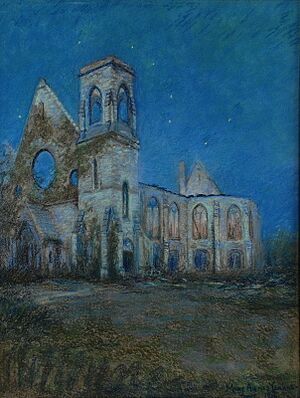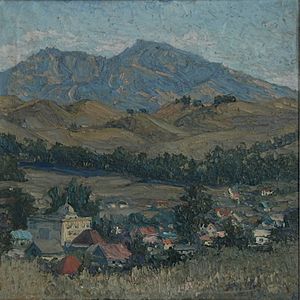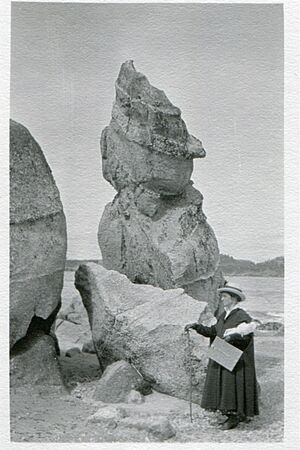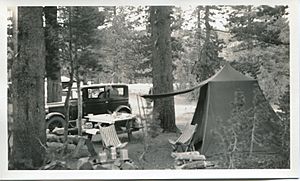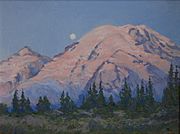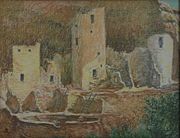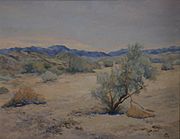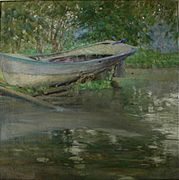Mary Agnes Yerkes facts for kids
Quick facts for kids
Mary Agnes Yerkes
|
|
|---|---|
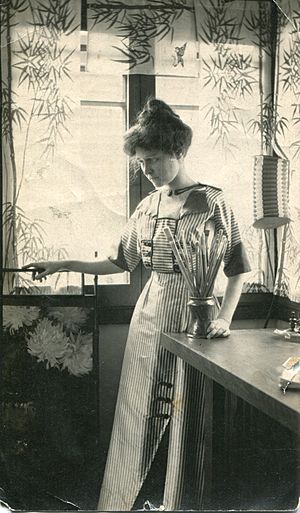
Mary Agnes in her studio.
|
|
| Born | August 9, 1886 Oak Park, Illinois, U.S.
|
| Died | November 8, 1989 (aged 103) San Mateo, California, U.S.
|
| Nationality | American |
| Education | School of the Art Institute of Chicago, Rockford College, Chicago Academy of Fine Arts |
| Known for | Painting |
|
Notable work
|
Crocker Art Museum, Illinois State Museum, Springville Museum of Art, Yosemite Museum NPS, Eiteljorg Museum, Whitney Gallery of Western Art, Tucson Museum of Art, Los Angeles County Museum of Art |
| Movement | American Impressionism |
Mary Agnes Yerkes (born August 9, 1886 – died November 8, 1989) was a talented American artist. She was known for her Impressionist paintings, photographs, and crafts. She worked with oil paints, pastels, and watercolors.
Even though the Great Depression made it hard for artists, Mary Agnes kept painting. She painted with great passion until she was over 90 years old. She loved nature and painting outdoors. She is famous for her "plein-air" paintings. These were done while camping in the American West and its amazing National Parks.
Contents
Growing Up in Chicago
Mary Agnes Yerkes was born in Oak Park, Illinois, on August 9, 1886. She was the third of four children. Her parents, Charles Sherman Yerkes and Mary Greenlees Yerkes, had moved there from Ohio. Mary Agnes finished high school in 1906. She quickly became a well-known artist in her hometown.
After her father died in 1908, her mother had a special house built in 1913. The architect, John S. Van Bergen, designed it. He was a student and friend of the famous architect Frank Lloyd Wright. Van Bergen often designed homes for artists and working women. He created an art studio upstairs just for Mary Agnes. He even designed parts of the first floor to frame her mural paintings.
Mary Agnes lived in this special house from 1913 to 1919. Her mother lived with her until she passed away in 1935.
Mary Agnes studied art history and design at Rockford College. She also went to the Chicago Academy of Fine Arts, where she later taught. She then studied at the School of the Art Institute of Chicago. She learned painting from famous teachers like Wellington Reynolds. Her work was shown in many art exhibits. These included shows at the Art Institute of Chicago from 1912 to 1915.
In October 1915, Mary Agnes had her own art show. A Chicago art critic wrote about her work. The critic said she was very good at many types of art. She used oil, pastel, and watercolor. Her paintings showed figures, landscapes, and still life. They also showed scenes from spring to winter snows. The critic praised her "clear, joyous, exquisite color." They believed she would become very famous for her use of color and imagination.
Life in California During the Depression
Many women artists found a new home in San Francisco, California. In 1917, Mary Agnes married Archibald Nelson Offley, a Navy Commander. They had a daughter, Mary, in 1918. Sadly, their daughter passed away at age 15 from a kidney illness.
Because her husband was in the Navy, they moved often. They lived in places like Portsmouth, Virginia, and several cities along the California coast. In the 1930s, they settled in San Mateo, California. This was during the Great Depression, a time when many people lost their jobs and money. Mary Agnes realized it would be hard to have a full-time art career.
Many artists struggled during this time. Some were lucky to get jobs painting murals in public buildings. But for most, their art careers were put on hold. Mary Agnes wrote in her journal about visiting a department store in San Francisco in 1935. The art director told her that "nobody is buying art during these times." This made her feel very discouraged.
Her husband had a steady job in the Navy. This meant their family was better off than many others during the Depression. They used their free time and saved money to explore the countryside. This allowed Mary Agnes to continue her artistic journeys.
Painting Outdoors in National Parks
Mary Agnes made Northern California her home base. This gave her easy access to some of the West's most beautiful natural places. She began painting mostly for herself. She traveled, camped, and painted from Yosemite Valley to Santa Fe. She also went from Tucson to Alberta, Canada.
Her husband kept detailed travel journals from the 1930s and 1940s. They showed all their adventures. They traveled in their special 1920s Buick car. It had extra storage and a canvas bed inside. Mary Agnes, her husband, and their daughter Mary (nicknamed Min) spent weekends and holidays exploring the new National Parks. They drove on dirt roads to find hidden spots.
They took many long trips across the West. They visited parks like Crater Lake, Mt Rainier, Glacier, and Yellowstone. They also saw Grand Teton, Rainbow Bridge, and Arches. Other parks included Mesa Verde, Joshua Tree, Death Valley, and the Grand Canyon. Yosemite was a special favorite because it was beautiful and close to their home.
Mary Agnes mostly painted outdoors, or "en plein-air." But she also worked in her studio at home. She took many photos on each trip to use as references later. Her husband, Archie, passed away in 1945. Mary Agnes paused her painting for a while. She started again in the 1950s with encouragement from her second partner, Albert Cobb. She did not remarry.
Mary Agnes continued to camp and paint the American West into the 1970s, even when she was in her nineties. She also made pictorial rugs, wove fabric for her clothes, and carved furniture. She used the same Southwestern and nature designs she loved to paint. She passed away in San Mateo on November 8, 1989, at 103 years old. When she died, over 150 of her paintings were hanging on her walls. The art world knows her as "Mary Agnes" Yerkes, but her family called her "Agnes."
Gallery
Signature Styles
Artists often have unique ways of signing their work. Mary Agnes Yerkes used different signatures over the years.
See also
 In Spanish: Mary Agnes Yerkes para niños
In Spanish: Mary Agnes Yerkes para niños


